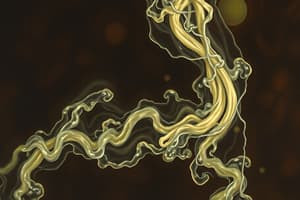Podcast
Questions and Answers
What is the primary function of salivary α-amylase in the mouth?
What is the primary function of salivary α-amylase in the mouth?
- To cleave starch and glycogen into α-dextrins (correct)
- To break down cellulose
- To convert sucrose to glucose and fructose
- To release glucose residues from branched oligosaccharides
What is the product of pancreatic α-amylase digestion in the intestine?
What is the product of pancreatic α-amylase digestion in the intestine?
- Glucose and galactose
- Sucrose and lactose
- Cellulose and glycogen
- Maltose, maltotriose, and small oligosaccharides (correct)
What is the function of oligo 1,6 glucosidase (α-dextrinase) in the intestine?
What is the function of oligo 1,6 glucosidase (α-dextrinase) in the intestine?
- To break down cellulose
- To cleave starch and glycogen into α-dextrins
- To release glucose residues from branched oligosaccharides (correct)
- To convert sucrose to glucose and fructose
What is the byproduct of lactase digestion in the intestine?
What is the byproduct of lactase digestion in the intestine?
Why do indigestible polysaccharides like cellulose pass through the intestine into the faeces?
Why do indigestible polysaccharides like cellulose pass through the intestine into the faeces?
What is the function of maltase (α-glucosidase) in the intestine?
What is the function of maltase (α-glucosidase) in the intestine?
What is the main cause of lactose intolerance?
What is the main cause of lactose intolerance?
Where is glucose absorbed through portal blood?
Where is glucose absorbed through portal blood?
What is the normal range of fasting blood glucose level?
What is the normal range of fasting blood glucose level?
What is the end product of glycolysis under anaerobic conditions?
What is the end product of glycolysis under anaerobic conditions?
Where does glycolysis occur in the cell?
Where does glycolysis occur in the cell?
What is the importance of glycolysis under aerobic conditions?
What is the importance of glycolysis under aerobic conditions?
Study Notes
Carbohydrate Metabolism
- Major dietary carbohydrates include starch, sucrose, and lactose, with small amounts of free glucose and fructose.
- Cellulose is an indigestible polysaccharide that passes through the intestine and is part of dietary fiber.
Digestion and Absorption
- Salivary α-amylase breaks down starch and glycogen in the mouth, producing α-dextrins.
- Pancreatic α-amylase breaks down α-1,4 linkages between glucose residues, producing maltose, maltotriose, and small oligosaccharides.
- Intestinal enzymes, such as oligo 1,6 glucosidase, sucrase, lactase, and maltase, break down oligosaccharides, sucrose, lactose, and maltose into glucose and other simple sugars.
- Lactose intolerance is caused by a lack of lactase enzyme in the small intestine, leading to symptoms such as abdominal pain, bloating, and diarrhea.
Fates of Absorbed Glucose
- Glucose is absorbed through portal blood to the liver, where it is converted to glycogen or oxidized by glycolysis for acetyl CoA and lipid synthesis.
- Fructose and galactose are converted to glucose in the liver.
- Glucose is used in oxidation, conversion to biologically active substances, storage, and excretion.
Oxidation of Glucose
- Glucose is oxidized through two main pathways: glycolysis and citric acid cycle (CAC) for energy production.
- Minor pathways for oxidation include hexose monophosphate shunt (HMS) and uronic acid pathway.
Conversion to Biologically Active Substances
- Galactose is essential for the formation of lactose, glycolipids, and mucopolysaccharides.
- Fructose is needed for the nutrition of sperms.
- Glucose is converted to non-essential amino acids, fatty acids, ribose-5-P, and glucuronic acid.
Storage of Glucose
- Glucose is stored as glycogen in the liver and muscles, and as triglycerides (TG) in adipose tissues.
Excretion of Glucose
- Glucose is excreted in urine when blood glucose levels exceed 180 mg/dl, a condition known as glucosuria.
Glycolysis
- Glycolysis is the degradation of glucose to generate ATP and provide intermediates for other synthetic and metabolic pathways.
- It occurs in the cell cytosol of all tissues and ends with pyruvate under aerobic conditions and lactate under anaerobic conditions.
- Phosphoglycerate kinase and pyruvate kinase are examples of phosphorylation at the substrate level.
- Two molecules of ATP are liberated in each step, with a total of 8 ATP produced per glucose molecule.
Importance of Glycolysis
- Glycolysis produces energy under aerobic and anaerobic conditions.
- It is a preparatory step for complete oxidation in tissues that have mitochondria.
Studying That Suits You
Use AI to generate personalized quizzes and flashcards to suit your learning preferences.
Description
This quiz covers the digestion and absorption of dietary carbohydrates, including the breakdown of starch, sucrose, and lactose by enzymes in the mouth and small intestine.




